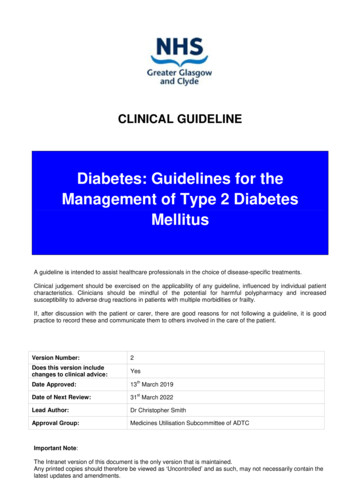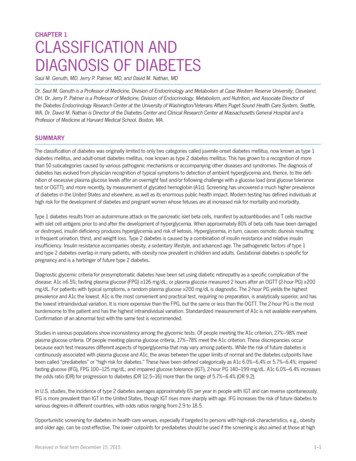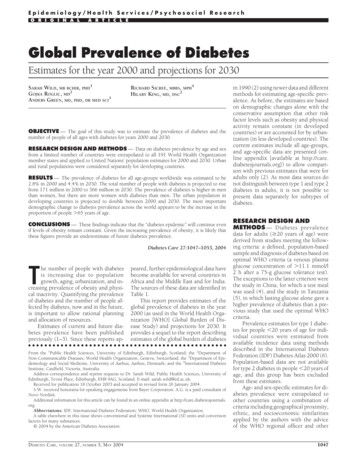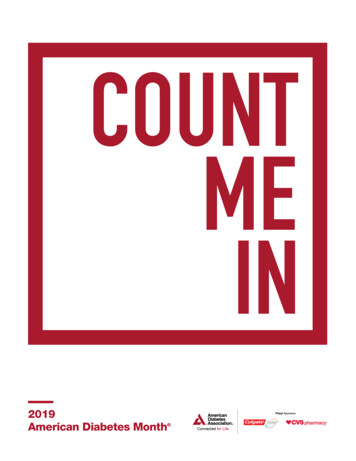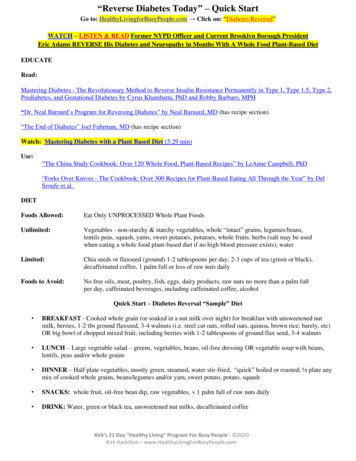
Transcription
“Reverse Diabetes Today” – Quick StartGo to: HealthyLivingforBusyPeople.com Click on: “Diabetes Reversal”WATCH – LISTEN & READ Former NYPD Officer and Current Brooklyn Borough PresidentEric Adams REVERSE His Diabetes and Neuropathy in Months With A Whole Food Plant-Based DietEDUCATERead:Mastering Diabetes - The Revolutionary Method to Reverse Insulin Resistance Permanently in Type 1, Type 1.5, Type 2,Prediabetes, and Gestational Diabetes by Cyrus Khambatta, PhD and Robby Barbaro, MPH“Dr. Neal Barnard’s Program for Reversing Diabetes” by Neal Barnard, MD (has recipe section)“The End of Diabetes” Joel Fuhrman, MD (has recipe section)Watch: Mastering Diabetes with a Plant Based Diet (5:29 min)Use:“The China Study Cookbook: Over 120 Whole Food, Plant-Based Recipes” by LeAnne Campbell, PhD“Forks Over Knives - The Cookbook: Over 300 Recipes for Plant-Based Eating All Through the Year” by DelSroufe et al.DIETFoods Allowed:Eat Only UNPROCESSED Whole Plant FoodsUnlimited:Vegetables - non-starchy & starchy vegetables, whole “intact” grains, legumes/beans,lentils peas, squash, yams, sweet potatoes, potatoes, whole fruits, herbs (salt may be usedwhen eating a whole food plant-based diet if no high blood pressure exists), waterLimited:Chia seeds or flaxseed (ground) 1-2 tablespoons per day, 2-3 cups of tea (green or black),decaffeinated coffee, 1 palm full or less of raw nuts dailyFoods to Avoid:No free oils, meat, poultry, fish, eggs, dairy products, raw nuts no more than a palm fullper day, caffeinated beverages, including caffeinated coffee, alcoholQuick Start – Diabetes Reversal “Sample” Diet BREAKFAST - Cooked whole grain (or soaked in a nut milk over night) for breakfast with unsweetened nutmilk, berries, 1-2 tbs ground flaxseed, 3-4 walnuts (i.e. steel cut oats, rolled oats, quinoa, brown rice, barely, etc)OR big bowl of chopped mixed fruit, including berries with 1-2 tablespoons of ground flax seed, 3-4 walnuts LUNCH – Large vegetable salad – greens, vegetables, beans, oil-free dressing OR vegetable soup with beans,lentils, peas and/or whole grains DINNER – Half plate vegetables, mostly green, steamed, water stir-fried, “quick” boiled or roasted; ½ plate anymix of cooked whole grains, beans/legumes and/or yam, sweet potato, potato, squash SNACKS: whole fruit, oil-free bean dip, raw vegetables, 1 palm full of raw nuts daily DRINK: Water, green or black tea, unsweetened nut milks, decaffeinated coffeeKirk’s 21 Day “Healthy Living” Program For Busy People - 2020Kirk Hamilton – www.HealthyLivingForBusyPeople.com
Key ‘Quick Start’ “Aids” for Diabetes Reversal Go To: HealthyLivingforBusyPeople.com Click On: Diabetes Reversal (Menu Bar) Scroll Down Page for Educational Links of Interest to You: Sign-Up for “Kirk’s Healthy Living Tips” on any of Kirk’s websitesHappy Cow App for your phone – plant-based restaurants & storesFREE whole food plant-based recipes and cooking instructions (more than 200 available on line)PlantPure “Quick Start” Resources – Meal delivery, online programs, support groups, DVDs, books, etc.Whole food plant-based companies shipped to your door-step (halfway down the page)Skim through “The Plant-Based Diet – A Healthier Way to Eat” (Kaiser Permanente)Consider whole-food-plant-based immersion programs 3-18 days – McDougall Programs, NewStart & 2Forks(same diet principles apply to heart disease reversal) Online plant-based cooking courses if desired: “Culinary-Rx.com” or “Forks Over Knives Online CookingCourse“ Books and cookbooks providing the scientific proof and recipes on reversing diabetes Podcasts with plant-based physicians, cardiologists, internists, surgeons & PhDs describe patient successes FREE transition program to a whole food plant based diet by following “Kirk’s 21 Day Healthy Living Program”– for 1 month (23 videos on right side of home page) then switch to a whole food plant based diet (no animalfood) with no added oils as your Diabetes Reversal Diet Coaching with Kirk Hamilton PA-C if you feel you need individual helpPlease Also Visit Masteringdiabetes.org StayingHealthyToday.com KwikerMedical.comEducational Resources Staying Healthy Today Show podcasts (iTunes/Website) https://www.youtube.com/user/StayHealthyTodayShow https://www.youtube.com/user/TheSloppyVegan/Social Media MENTS SUPPORTIVE OF DIABETES HEALTH & BLOOD SUGAR CONTROL Aged garlic extract 600 mg 1-2 2 x day (reverse soft plaque – diabetics CVD risk)Alpha lipoic acid 100-300 mg/d ( BG)Berberine 150-300 mg 2 x daily ( BG)Carnitine 1000-3000 mg/d ( BG) (check TMAO levels)Chromium 400-800 mcg/d ( BG, insulin)CoQ10 (Ubiquinol) 100-200 mg/d ( insulin, blood sugar, oxidative stress)Culturelle 1-2/d ( good gut bacteria)EPA/DHA (algae) 2-4 gm/d ( insulin, HbAc1, TC, TG, and BMI)Magnesium 200-600 mg/d ( diabetics)Multivitamin/Mineral 2-4/dRibose 5 gm 3 x daily ( BG)B complex (50-100 mg/d) (CHO Glucose)Vitamin B1 50-100 mg (CHO Glucose)Folic acid – 5MTHF 1 mg ( homocys, by metformin)Vitamin B6 25-50 mg ( homo, BG )Vitamin B12 1000 mcg ( by metformin, homo)Vitamin C 1000 mg ( BG, A1c)Vitamin D 5000-10,000 IU ( BG, insulin sensitivity)VSL#3 1-2/d ( good gut bacteria)Zinc 30-50 mg/d ( insulin, BG, A1c)Kirk’s 21 Day “Healthy Living” Program For Busy People - 2020Kirk Hamilton – www.HealthyLivingForBusyPeople.com
Kirk’s 21 Day “Healthy Living”Program For Busy People Read “Staying Healthy in the Fast Lane” TRIAD Wellness Program pages 133-193 (1-3/wks)Week 1Add: Week 2 1 large salad daily – as themeal (oil free dressings only) ½ - 1 cup cooked beans daily(145-146)Add: Week 3 Eat off BED Diet food list x 2weeks (118,119, 135, 201-204) No more than a palmful or‘deck of cards’ of animal fooddaily (Preferably None) (xvii- No Oils (4, 5, 9, 12, 139, 143, 149) No processed carbohydrates(10, 89-94, 115-117)(only whole or sprouted grains, Greens/Fruit (75/25) Smoothiestarchy vegetables, fruit & nowith ¼ cup flax or chia seedsadded sugars) (6,11,12, 24, 37-38, 94- 64 oz in day or 2-3 whole fruits100, 106-114, 116, 136, 140-142,148)daily. (140, 142, 144-145, 153) Sit still for 15-30 minutes daily (188-193) Walks 15-30 minutes daily (39,(81-88, 135-7, 140, 144-148) No dairy products AT ALL159-167)xviii, 5, 6, 9, 38, 67-88,135)1-2 palmfuls of raw nuts orseeds daily (142, 147-148)Strength training 3-4 daysweekly 15-30 minutes (167-177)Super Salad: Commit to eating one LARGE salad every day for 21 days (even if it takes all day). UseTupperware type container 3 inches deep and 8 X 8 inches square.Leafy Greens - Mix 1 to 3 different kinds of organic greens – Romaine, mixed or spring greens, spinach, kale,arugula, etc. into container (above).Vegetables – add at least 4-5 different vegetables – bell peppers, carrots, celery, cucumber, parsley, snap peas,green onions, leeks, tomatoes, Jicama, olives (actually a fruit), etc.Fruit – add 1-2 fruits to the salad - berries (blue, black, raspberries, pomegranate, grapes, etc) and whole fruitsliced (apples, pears, nectarines, peaches, orange, tangerine, grapefruit , etc).Legumes/Beans – ½ - 1 cup organic beans (garbanzo, black, kidney, pinto, edamame, canned are acceptable).Rinse beans off in strainer before use.Nuts/Seeds – 1-2 tablespoons of raw nuts or seeds (1 tablespoon flax or chi seeds always) are optional in salad.Dressing - Cut up wedges of oranges, lime, lemons or grapefruit – 4-6 wedges per salad. Can freshly squeezedjuice directly onto salad – or - add to these juices that are freshly squeezed – dill, sea salt, garlic pepper, currypowder, bay leaves, sesame seeds. Vinegars may be used.Super Green “Hyper-Nourishing” Smoothie (in strong blender) – (For healing, energy,weight loss and increased metabolism) - 75% compressed greens / 25% raw or frozen berries, banana, mango,pineapple; 1 palm full (1/4 – 1/2 cup) raw flax or chia seeds (start at 1 tblspn daily till ¼-1/2 cup total; water tofruit line – 64 oz to be consumed in a day. If muscle building can add tofu, edamame, almond butter, non-soyvegan plant protein, organic nut milks (almond, oat, rice) – water total (including smoothie) 96 oz per day.Super Simple Soup - 2-4 quarts of organic vegetable broth; chop up 3-5 different kinds of vegetables;½ -1 cup of beans; herbs and spices (garlic, sea salt, dill, basil, etc.); simmer 10-20 minutes; add 5 minutesbefore serving a palmful of cooked brown rice, quinoa or other non-glutinous grain. The grains may beprecooked. Simmer for 5 minutes and serve.Super Simple “Lifesaver” Bean Dip to Smooth Your Blood Sugar, Reduce Cravingsand Provide Good Carbs, Protein and Fats – 1 – 2 cans of organic cooked beans (pinto, black, kidney,garbonza, etc.) poured in Quisinart (food processer). Add juice from lemon, lime or orange (or vinegar) to taste with garlicpowder (or real garlic), dill, and any other herbs and spiced to taste. Can add avocado if weight is under control, or anyother juicy vegetable (tomatoes, etc.) for texture. Blend to desired smoothness. Use for vegetable dips, sandwichspreads, finger food, between meal hunger! (No added oils!). NO MORE CREAMY, CHEESEY, FATTY, GOOEYDIPS!It is also recommended that you:Use the Diet-Exercise-Symptom Diary BELOW to log your progress. Weigh yourself daily in the morning and evening and log weight on your Food-Diary. Do some form of aerobic exercise daily for a minimum of 15-30 minutes (pgs. 166-167). Sit physically still 15-30 minutes twice daily (pg. 188). Do some form of strength training (i.e. circuit training) 3-4 days per week (pgs. 167-177).Kirk’s 21 Day “Healthy Living” Program For Busy People - 2020Kirk Hamilton – www.HealthyLivingForBusyPeople.com
Basic Elimination Diet (BED)(Shopping List)Vegetables (75% raw/greens)Alfalfa SproutsArtichokeAsparagusAvocadoBeans (string)BeetsBok ChoyBroccoliBrussels SproutCabbageCarrotsCauliflowerCeleryChardCollard GreensCucumberDaikon tuceMushroomsMustard w PeasSpinachSquashSweet PotatoSwiss ChardTurnipsWater ChestnutsYamsZucchini(add night shades back in 2 weeks –tomato, eggplant, peppers,potatoes)Fruit (add citrus back in 2 WatermelonGrainsAmaranthBuckwheatCorn (cob & tortilla)MilletOat Groats, Steel-Cut orRolled OatsRice Brown or WhiteRice Cakes/Cereal (plain)Rice MilkRice PastaQuinoaBeans/LegumesDried BeansDried PeasEdamameLentilsMisoSoy MilkTempehTofu (Soy Bean)Nuts and SeedsAlmonds (& almond milk)CashewsChia seedsFlax seedsHazelnutsPecansPumpkin SeedsSesame SeedsSunflower SeedsWalnutsAnimal d GameCodHalibutMackerelSalmonSoleTroutTunaKirk’s 21 Day “Healthy Living” Program For Busy People - 2020Kirk Hamilton – www.HealthyLivingForBusyPeople.com
Grocery Shopping in the Fast LaneTo shop healthfully is very simple and, in the right store, can be easily done in less than a half-hour withsome very basic principles. While I am a big supporter of organic foods and eating seasonally and locally, Ithink it is incorrect to say America can’t improve its health dramatically by shopping for non-organicwhole food in the basic grocery store. To improve health, you first have to stop eating processed foods thatdo you no good, and even harm you, then eat quality foods that are good for you.Principles of Grocery Shopping in the Fast Lane1.Shop the outside, or “perimeter,” of the grocery store where the whole, unprocessed foods are (fruit,vegetables, lean meats, etc.). Eat whole foods only (organic if possible). Buy the basics: vegetables(raw/frozen); fruit (raw/frozen); raw nuts and seeds; beans (canned/packaged); whole grains and sproutedwhole grain (try non-glutinous whole grains such as brown rice, quinoa, millet, amaranth, buckwheat);water, mineral water, teas, and real juices (100 percent juice); animal foods (optional): eggs, fish, leanfowl, and meat (free-range or grass-fed if possible).2.If you buy oils, get extra-virgin olive oil, avocado oil and/or cold-pressed canola oil for cooking andground flaxseed or cold-pressed vegetable oils for salads and for cold sauces. Keep oils to a minimum.3.Do not buy dairy products at all (not from a cow, goat, or sheep; not milk, cheese, yogurt, ice cream,cottage cheese, kefir, butter, etc.) for at the very least one month completely. For your whole family.*Please don’t give a child under two years of age any cow’s milk products at all on a regular basis. Asidefrom food intolerance leading to chronic upper respiratory infections and gastrointestinal problems, ofequal concern is that the early introduction of cow’s milk products in children may increase the risk of type1 diabetes, which is not reversible. After the child is weaned, ideally from the mother’s breast, rotate inorganic almond, soy, rice, or other grain milks, fortified with calcium and vitamin D if you are concerned,and watch for reactions.4.If you want a sweet, refined grain or fatty food, don’t put it in your shopping cart. Go outintentionally and buy it later by itself. Only shop for whole foods and only have whole foods in your house.Build that habit and that base. Then when you choose to eat “junk,” enjoy it—but not too much, and onlywhen you are in control of your health!Stocking Your Refrigerator and Cupboards: The BasicsLet’s go to the fridge first. When you open the refrigerator, the vegetable bin should be filled withvegetables, pre-washed or fresh salad greens, spinach, chard, kale, collards—as much green, leafyvegetables as possible. Green, leafy vegetables are not only nutrient packed, but they are also 100 percentnon-fattening. You are getting the most nutrients per calorie when you are eating leafy greens. Frozenvegetables are fine to have in your freezer as well.Next, your fruit bin should always be full. I keep blackberries, blueberries, raspberries, or strawberries onone of my upper shelves, and the fruit bin is filled with whatever fruits are in season (or in the producesection), which could be apples, kiwis, nectarines, peaches, plums, oranges, grapefruit, and tangerines. Imight have some bananas outside the refrigerator. For smoothies and things of that nature, it is easier tokeep frozen fruit in your freezer section. Frozen is usually cheaper and you can get organic versions aswell.Kirk’s 21 Day “Healthy Living” Program For Busy People - 2020Kirk Hamilton – www.HealthyLivingForBusyPeople.com
I keep raw nuts or seeds in the freezer. I will usually have some almonds, walnuts, pecans, and sunflowerseeds. Pumpkin seeds are a very nutritious food, but for some reason don’t resonate with me. Generally, Idon’t eat a lot of cashews and pistachios because I tend to be sensitive to them as well.In my cupboards I always have cans of cooked beans (mostly organic) and also whole-food, organic typesof soups such as minestrone, lentils, split pea, Cuban black bean, and other vegetarian things like chili. Mycanned products are meatless. I encourage you to do this as well. You can always add meat to them later ifyou must. I buy several quarts of an organic vegetarian broth to be used in soups, to stir fry, to “quickcook” my greens, or sometimes cook my pastas or grains in. (The organic vegetable broths in the quartcontainers have really been a lifesaver for me and revolutionized my cooking!) It is also good to have a fewquarts of marinara sauce on hand (organic is easily available). Your cooking grains can be in the cupboardor freezer, and remember that the first ingredient for any grain or flour product ideally should be “wholegrain” or “sprouted grain.” I usually have a loaf of sprouted, whole-grain bread in my freezer and one onthe shelf in my refrigerator.I do use, sparingly, extra-virgin olive oil (monounsaturated fat) for cooking sometimes. I have been moreoil-calorie conscious lately, since really becoming aware that added oils are one of the biggest reasons forexcess calories in our diet. I try to get most of my oils from nuts and seeds and avocados. If you are leanhaving a small amount of cold-pressed oil or spread or extra-virgin olive oil is probably fine. If you havenever gone oil, nut, seed and avocado free, try it for two weeks. It is an interesting experiment. I droppedfive pounds without even trying.Have herbal teas around, especially green, black, and white teas. Mineral water can be used along withbottled or filtered water. The goal is to drink five or six glasses of water a day. If you feel you have to havesome type of milky substance, there are soy, almond, and other different types of “milks,” including hemp,hazelnut, oat, multigrain, and rice milks. These can all come fortified with calcium and vitamin D. Buy avariety of them and see which ones resonate with you. When you add a new food, always ask yourself howyou feel. Even if on paper it looks good nutritionally but you don’t feel well, trust that. There is always analternative that is nutritious. Always.If you get fish, poultry, or beef, ideally it should be wild fish and/or poultry or red meat that is grass-fed,free-ranged, and without hormones and antibiotics, or hunted game. These would round out the refrigerator.I realize some whole-food purists, whom I respect, might look down on eating canned goods or prepackaged, pre-washed vegetables. Ideally I’d grow my own vegetables, eat totally from my fruit trees, cookall my beans, and wash my own lettuce and greens every day, but it is not practical for me time-wise. Onegood thing about modern urbanization is that some businesses have done some smart things to make eatinghealthy in a busy world easier. By shopping and eating in this way, we can not only be healthy, but we canalso help create a new, sustainable economy and jobs centered around producing whole, healthy foods thatare convenient for people in the busy, modern world.Eating out in the Fast LaneWhether you eat at a fast-food restaurant or a high-end establishment, these simple guidelines can help youreduce your calories, increase your nutrient intake, and do more good than harm with meals eaten awayfrom home.Kirk’s 21 Day “Healthy Living” Program For Busy People - 2020Kirk Hamilton – www.HealthyLivingForBusyPeople.com
Avoid all creamy, cheesy sauces and dressings, and dips on any dish. Avoid all dairy products (cheeses, ice cream, milk, cottage cheese, sour cream, etc.). You have toask to have dairy, especially cheese and sour cream, removed from many dishes. Presently mostrestaurants just add cheese and sour cream as normal fare to many foods. Don’t order bread or chips before your meal or have them come with your meal. Order your salad with a dairy-free dressing on the side (vinaigrette, olive oil, etc.). Order plant-based appetizers if you are starved (grilled mushrooms, garlic sautéed spinach, salad rolls,lettuce cups, seaweed or cucumber salad, edamame, miso or minestrone soup, grilled vegetables, etc.). If you want to go completely vegetarian and there is nothing on the menu, you can just havemultiple vegetarian appetizers, side dishes, and salads. I do this frequently. Ask the chef to make you a big plate full of sautéed or grilled vegetables—whatever they have available.They’ll generally do it happily! Avoid having your food fried. Request it baked, broiled, steamed, or stir-fried. Have it light on oil, evenolive oil. Order quick foods without added oils, salt, cheeses, mayonnaise, or sauces. Ask for whole-grain breads, but most restaurants don’t have them. Replace meat with beans in fast foods when possible (on tacos, burritos, etc.). Have as many animal-freemeals as possible. Leave the animal meats and products out of fast food if you can. Just ask. I do this withbeans instead of meats. And of course no sour cream, cheese, mayonnaise, or creamy sauces! Have water instead of soda. Or have a small-sized soda with a cup of water. Have a pizza with the crust, tomato sauce only, and all the vegetables they want to throw on it. The goalof eating out healthy, or doing the least amount of harm, is to keep excess calories to a minimum and eat asmany unprocessed foods as possible. That is achieved by keeping creamy sauces and added oils off yourbasic foods; not eating lots of pre- main course snack foods; keeping high-calorie foods out of your maincourses (cheeses, creamy sauces, and oils); avoiding deep fried food; avoiding alcohol; and eating as manyvegetables in salads, appetizers, or in your main course,as possible.Controlling Food CravingsThe key to controlling food cravings is to eat lots of good, whole food that gives you an even blood sugarfrom time-released carbohydrates and adequate protein, and has lots of fiber or natural bulk from watercontent. In addition, these whole foods should be nutrient dense, packed with lots of vitamins, minerals,antioxidants, and phytochemicals. Dr. Joel Fuhrman (Eat to Live, 2011) and colleagues recently showed ina study in the Nutrition Journal that the higher the micronutrient density of the diet, the less hunger peoplehad while consuming fewer calories. You should also keep to a minimum or eliminate foods that increasethe risk of blood sugar swings (e.g., excess caffeine, simple sugars, etc.). Eat whole, unprocessed foods only. Have whole, unprocessed snacks between meals (fruit, nuts, seeds, bean spreads, whole-grain snacks). Eat only good, unrefined carbohydrates (beans, whole grains, fruit, starchy vegetables). Keep only whole foods in your house (refrigerator, cupboards). Go out and buy the craved food if you must. Don’t have it lying around in your house. If you must satisfy a food craving, have it with or after a whole-food meal, not as a separate snack. Exercise regularly. Many times this will subdue your food cravings. Bring whole-food snacks to work, recreational activities, and have them in your car. Realize that many foods are addictive, especially ones containing simple sugars, caffeine, chocolate, dairyproducts, and refined grains (e.g., wheat). Avoid completely or at least take breaks from them every fewdays.Revised 03-02-20Kirk’s 21 Day “Healthy Living” Program For Busy People - 2020Kirk Hamilton – www.HealthyLivingForBusyPeople.com
DateTimeWeightBP/PulseFoods EatenKirk’s 21 Day “Healthy Living” Program For Busy People - 2020Kirk Hamilton – www.HealthyLivingForBusyPeople.comSymptomsExercise
“Reversing Diabetes & Obesity by Returning to Their Traditional Fiber Rich Diets ”The Story of the Pima Indians of Arizona It’s their Lifestyle Not Their Genes!To Preserve Their Health and Heritage, Arizona Indians Reclaim Ancient Foods(The New York Times, 1991 Archives by Jane Brody) Also read about the Pima’s traditional high carbohydrate, low fat diet whenthey had virtually NO diabetes: Diabetes Care 1993 Jan;16(1):369-371 Proceedings of the Nutrition Society (1998), 57, 175-181J Clin Endocrinol Metab,73(1):56-65 Jul 1991 and Am J Clin Nutr. 1990 Mar;51(3):416-20.GOING back to one's roots could soon take on a more literal meaning for the Indians of the American Southwest, as wellas for peoples elsewhere in the world who are poorly adapted to rich, refined foods.For the sake of their health, as well as their cultural heritage, the Pima and Tohono O'odham tribes of Arizona are beingurged to rediscover the desert foods their people traditionally consumed until as recently as the 1940's.Studies strongly indicate that people who evolved in these arid lands are metabolically best suited to the feast-and-faminecycles of their forebears who survived on the desert's unpredictable bounty, both wild and cultivated.By contrast, the modern North American diet is making them sick. With rich food perpetually available, weights in thehigh 200's and 300's are not uncommon among these once-lean people. As many as half the Pima and Tohono O'odham(formerly Papago) Indians now develop diabetes by the age of 35, an incidence 15 times higher than for Americans as awhole. Yet before World War II, diabetes was rare in this population.Similar problems have been found among Australian aborigines, Pacific Islanders and other peoples whose survivalhistorically depended on their ability to stash away calories in times of plenty to sustain them during droughts and cropfailures. The Pima and Tohono O'odham Indians seem unusually efficient at turning calories to body fat; nutritionists saythey gain weight readily on the kinds and amounts of foods people of European descent can eat with no problem.Preliminary studies have indicated that a change in the Indian diet back to the beans, corn, grains, greens and other lowfat, high-fiber plant foods that their ancestors depended upon can normalize blood sugar, suppress between-meal hungerand probably also foster weight loss.These findings may also prove valuable to non-Indians who are susceptible to overweight and diabetes, and perhaps alsothose prone to high blood pressure and heart disease. The benefits, which are also found in a few more familiar foods likeoat bran and okra, stem primarily from two characteristics of the native foods: their high content of soluble fibers thatform edible gels, gums and mucilages, and a type of starch called amylose that is digested very slowly. The combinedeffect is to prevent wide swings in blood sugar, slow down the digestive process and delay the return of hunger.Peaks in blood sugar increase the body's need for insulin and dips in blood sugar can trigger feelings of hunger. In theform of diabetes that strikes these Indians the overweight body becomes insensitive to insulin. Weight loss increases thebody's sensitivity to insulin and slow digestion diminishes the need for insulin.On the Arizona desert, the desirable food ingredients are found in edible parts of such indigenous plants as the mesquite(mes-KEET) tree, cholla (CHOY-a) and prickly pear cactus, as well as in tepary (TEP-a-ree) beans, chia (CHEE-a) seedsand acorns from live oaks. Tribal elders speak fondly of these one-time favorites, which in recent decades have been allbut forgotten as hamburgers, fries, soft drinks and other fatty, sugary, overly refined fast and packaged foods gained favor.Even those Indians who still rely heavily on beans and corn are today consuming varieties that have little or none of thenutritive advantages found in the staples of their historic diet. For example, the sweet corn familiar to Americans containsrapidly digested starches and sugars, which raise sugar levels in the blood, while the hominy-type corn of the traditionalIndian diet has little sugar and mostly starch that is slowly digested.
Similarly, the pinto beans that the Federal Government now gives to the Indians (along with lard, refined wheat flour,sugar, coffee and processed cereals) are far more rapidly digested than the tepary beans the Tohon O'odham oncedepended upon. Indeed, their former tribal name is a distorted version of the Indian word meaning "the Bean People."When Earl Ray, a Pima Indian who lives near Phoenix, switched to a more traditional native diet of mesquite meal, teparybeans, cholla buds and chaparral tea, he dropped from 239 pounds to less than 150 and brought his severe diabetes undercontrol without medication. In a federally financed study of 11 Indian volunteers predisposed to diabetes, a diet of nativefoods rich in fiber and complex carbohydrates kept blood sugar levels on an even keel and increased the effectiveness ofinsulin. When switched back to a low-fiber "convenience-market diet" containing the same number of calories, thevolunteers' blood sugar skyrocketed and their sensitivity to insulin declined. Much Foliage, Few BeansIn addition to the potential health benefits of traditional desert foods, agricultural and economic factors strongly favortheir production. Marty Eberhardt, the director of the Tucson Botanical Gardens, pointed out that the plants that producethese foods are naturally adapted to growing under conditions of high heat and little water.Martha Burgess, education director of Native Seeds/Search, a seed bank and research and education organization here thatstudies and promotes the use of native desert plant foods, said, for example, that "if tepary bean plants are given lots ofwater, they produce tons of foliage and few beans," adding, "But if the plants are starved of water, they put their effortinto flowers and seeds and produce beans that can have as much protein as soybeans."Under the direction of Dr. Gary Paul Nabhan, Native Seeds/Search, the (the acronym stands for Southwestern EndangeredAridlands Resource Clearing House) is studying the value of native desert foods for controlling diabetes among Indiansand Hispanic Americans of the border region. Dr. Nabhan, an ethnobotanist, was recently named a recipient of aMacArthur Foundation grant to pursue his studies of the agronomic characteristics and health value of desert food plants.The group, which is housed on the grounds of the Tucson Botanical Gardens, teaches health professionals about nativefoods and promotes their use through school and community programs, seed distribution and cooking instruction."We should be eating the foods that grow here naturally instead of spending so much to bring in packaged foods," Ms.Eberhardt said. "People find themselves shin-deep in mesquite beans they don't know what to do with, and some of us feelguilty throwing them into the landfill."Although most Arizonans consider mesquite, which occupies 70 million acres in the American Southwest, a pesky weed,it is loaded with nutritious pods that have a natural caramel-like sweetness. Carolyn J. Niethammer, the author of"American Indian Food and Lore" and "The Tumbelweed Gourmet," a cookbook published by the University of ArizonaPress that features desert plants, said that mesquite pods were good sources of calcium, manganese, iron and zi
Kirk’s 21 Day “Healthy Living” Program For Busy People - 2020 Kirk Hamilton – www.HealthyLivingForBusyPeople.com “Reverse Diabetes Today” – Quick Start Go to: HealthyLivingforBusyPeople.com Click on: “Diabetes Reversal” WATCH – LISTEN & READ Former NYPD Officer and Current Brooklyn Bo





